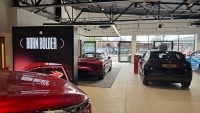Stellantis has rubber-stamped plans to axe 138 dealerships as part of wider plans to streamline its business amid a drastic shake-up in management.
In a media call, Stellantis UK group boss Paul Willcox and network development director Lee Titchner revealed ‘significant’ restructuring plans for Stellantis’s UK operations.
It includes senior management changes, simplification of dealers’ business models and a refreshed dealer network to encompass multi-franchising.
A key component of the changes involves a major new focus on customer experience.
In May 2021, dealers were put on a two-year notice period.
Now the full scale of the restructure has been revealed, with 138 dealerships disappearing by May 2023 – and most of them are losing their franchises as a result of offering poor customer service.
What’s more, Stellantis admitted there was no ‘endpoint goal’ to the eventual size of the network.
‘The impact of the 138 drop takes the investor count to 176,’ Titchner said.
‘We don’t have an endpoint goal. What we need is a mutual dependency – a commitment to customer experience and the drive to simplification.
‘That doesn’t mean we have an endpoint in sight with regard to the number of investors. It clearly needs to continue to reduce, but I think we can do that in a pragmatic way.’
‘Simplification’
Titchner explained that the coming together of ‘different businesses’ revealed differences on how brands partnered with new dealers, and now the company – which represents Peugeot, Citroen, Fiat, Abarth, Jeep, DS Automobiles and Alfa Romeo among others – desires ‘simplification’ in the way it does business.
‘We need one common strategy for Stellantis, and the main reason for that is we need to continue to drive simplification – one of the massive things for us moving forwards is to be able to have mutual dependency,’ he said.
‘What I mean by that is we need to be important to retail partners, and they also need to have the scale to be as important to us, too.
‘The only way to do that is to drive down our investor [dealer] count.’
He added: ‘We will continue to revisit our plan to drive that down further to consolidate the investors even more.
‘We need to be in a position where we’re talking about all the brands to our investors and that we don’t have specialists in one or two brands.
‘The aim is to have 20 per cent market share [car and van] by 2025 – we want to go out and talk to our partners about the opportunity to have 20 per cent of the market, which is a compelling commercial proposal.’
Part of that will involve multi-franchising.
Brand-first
‘The way we will operate is brand-first,’ said Titchner.
‘What that means is that customers will buy from the brand [brands within Stellantis] and we will use the machine of Stellantis to drive the quality of customer experience.
‘One of the ways we will do this is to go multi-franchising – enabling our partners to have that one brand on each site, to drive that throughput and commerciality, but also to drive the customer experience.
‘What that doesn’t mean is that we will provide derogation of any of the brand values.
‘In driving that multi-franchising format, we will always deliver on brand expectation. You will never see one of our brands tucked into the corner – all of the branding will be done properly.
‘The defining relationship will be the quality of the customer experience.’
During the call, it was revealed that Stellantis is planning on having a handful of dealers that offer all its brands – called ‘Stellantis Houses’ internally.
Titchner said it wasn’t a ‘pre-requisite’ for dealers to be multi-franchise, or even a strategy to have Stellantis Houses, ‘but where the opportunity exists, we will explore it. There won’t be many of them, but they will exist’.
Willcox, who became Stellantis’s UK boss in June, revealed that the firm is creating a ‘premium division’ to be headed up by current Peugeot MD Julie David.
It will consist of Alfa Romeo and DS Automobiles, as it embraces the agency sales concept from next year.
Willcox said: ‘The new division will support the growth and the development of those brands.
‘We need a strong elevation in terms of the customer journey and improving the customer experience.’
‘Frictionless’ operation
Along with simplifying its dealer network, Stellantis will also streamline its operational structure in the UK to create a ‘frictionless’ relationship between the company and its dealers.
‘We are significantly streamlining our interface with the network for our mainstream brands – Vauxhall, Peugeot, Citroen, Fiat and Abarth, and Jeep,’ explained Willcox.
‘We’re going to manage them with a new centralised operational function.
‘We want to take advantage of the scale and diversity of the brands, but also we want to streamline. We want to create a frictionless relationship with our partners.
‘We’re going to manage the relationship with our retailer partners across brands, from sales, aftersales, quality of the customer experience and from a network development perspective.
‘We’re going to create a regional structure that will drive quicker decision-making.
‘It will create an environment where there’s common ownership of the objectives and the challenges that we face, and we strongly believe that will deliver – compared to today, which is a much more fragmented approach – a single point of contact and ownership of the issues that our retailers face.’
Along with the streamlining process, Stellantis is also shuffling its senior management, with new directors for its mainstream brands, and creating a new network operations department to be headed up by current Citroen MD Eurig Druce.
‘We will always have dealers’
The call also confirmed that Stellantis will continue to invest in digital elements of the customer journey and push an ‘omni-channel’ approach.
Willcox ruled out – in the short term at least – turning some of its brands to purely online sales.
‘We don’t see a future without physical representation of the brands – we will always have retail partners.
‘But the scale of those partners and how we manage that obviously in five years’ time may be completely different.
‘Our expectation is we want to drive more engagement digitally, because that’s the way consumers are engaging with brands these days.
‘But the automotive industry is a little bit behind them and it’s become much more progressive.
‘We’re investing heavily as a group, both globally and regionally, in terms of developing these tools.’
He added: ‘I think it would be a big mistake to say we’re going to close our showrooms and we’re going online.
‘That would be too much of a revolution and I’m not the man to take that level of risk!’


































